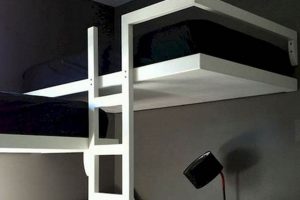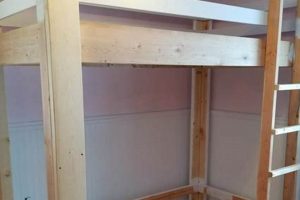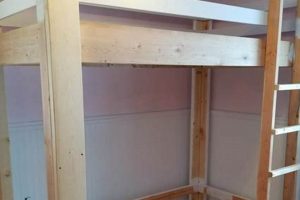A protective coating applied to the bed of a truck, typically to prevent damage from cargo, can be installed by the vehicle owner. This process involves surface preparation, material application, and curing, offering a potentially cost-effective alternative to professional services. The resulting layer shields the truck bed from scratches, dents, and corrosion, extending its lifespan and maintaining its aesthetic appeal.
Implementing this protective measure enhances the utility and longevity of a pickup truck. Historically, owners sought methods to safeguard their vehicles from the rigors of hauling materials. This approach can save money, granting individuals control over the application process and material selection. Such initiatives reflect a desire for self-sufficiency and customization in vehicle maintenance.
The following sections will detail the specific types of coatings available, outlining the tools and materials required for successful application. Further discussion will cover essential preparation steps, application techniques, and crucial safety precautions to ensure optimal results and user well-being.
Application Best Practices
Achieving a durable and aesthetically pleasing finish requires meticulous attention to detail throughout the application process. The following guidelines outline key considerations for success.
Tip 1: Thorough Surface Preparation: Prior to any coating application, the truck bed surface must be completely clean and free from rust, dirt, grease, and loose paint. Sanding or media blasting may be necessary to create an optimal bonding surface. Failure to properly prepare the surface will compromise the adhesion and longevity of the coating.
Tip 2: Priming for Adhesion: Apply a suitable primer designed for the specific coating material. The primer promotes a strong bond between the truck bed and the coating, preventing peeling and chipping. Follow the manufacturer’s instructions regarding application thickness and drying time.
Tip 3: Optimal Environmental Conditions: Application should occur in a well-ventilated area with moderate temperature and humidity. Extreme temperatures or high humidity can negatively impact the curing process and the final finish. Consult the product specifications for recommended environmental parameters.
Tip 4: Even Application Technique: Whether using a spray gun or a roller, maintain a consistent distance and speed to ensure uniform coating thickness. Avoid applying too much material in one area, which can lead to runs or sags. Multiple thin coats are preferable to a single thick coat.
Tip 5: Proper Curing Time: Allow the coating to cure completely according to the manufacturer’s instructions. Premature use of the truck bed can damage the uncured coating and compromise its protective qualities. Adherence to the recommended curing time is crucial for optimal performance.
Tip 6: Masking and Protection: Protect surrounding areas of the truck from overspray or spills by using masking tape and protective sheeting. This will ensure a clean and professional-looking finished product.
Careful execution of these steps yields a durable, protective layer, increasing the truck’s lifespan. Diligence and attention to detail are paramount.
The final section will summarize the information provided, reinforcing the importance of proper planning and execution.
1. Material Selection
The selection of coating materials is paramount in the efficacy of a protective bed layer for a pickup truck. The chosen compound directly influences the level of protection against abrasion, impact, chemical exposure, and ultraviolet (UV) degradation. Incorrect material selection can lead to premature failure of the coating, rendering it ineffective and necessitating costly repairs. For example, a coating formulated for primarily aesthetic purposes may prove inadequate in a heavy-duty work truck subjected to frequent loading of construction materials.
Different coating types offer distinct advantages and disadvantages. Polyurethane-based products are known for their exceptional durability and resistance to abrasion, making them suitable for applications involving sharp or heavy objects. Epoxy coatings provide excellent chemical resistance, ideal for trucks frequently exposed to solvents or corrosive substances. Rubberized coatings offer good impact absorption and sound dampening properties, but may be less resistant to abrasion. Understanding these trade-offs is crucial for selecting a material that aligns with the specific demands placed on the truck bed.
Ultimately, the success hinges on matching the material properties to the intended use of the truck. Careful consideration of factors such as load type, frequency of use, and environmental conditions will guide the selection process, maximizing the protective benefits and extending the lifespan of the coating. Failure to prioritize appropriate material selection undermines the entire protective initiative, leading to diminished performance and increased maintenance requirements.
2. Surface Preparation
The longevity and protective efficacy of any truck bed coating are inextricably linked to the quality of the initial surface preparation. The application of a coating to an inadequately prepared surface almost invariably results in premature failure, negating any perceived cost savings. Contaminants such as rust, grease, and loose paint inhibit proper adhesion, leading to peeling, chipping, and ultimately, a compromised barrier against damage. Effective surface preparation is not merely a preliminary step; it is a fundamental component of a successful protective system. Consider, for example, a truck bed with existing rust. If the rust is not completely removed prior to coating application, it will continue to corrode beneath the new layer, eventually undermining its integrity.
Achieving an optimal surface typically involves a combination of mechanical and chemical processes. Media blasting, sanding, and grinding are common methods for removing existing coatings, rust, and other surface imperfections. Chemical treatments, such as degreasers and etching solutions, further cleanse the surface and promote adhesion by creating a slightly roughened texture. The selection of appropriate preparation methods depends on the existing condition of the truck bed and the type of coating being applied. Failure to adequately degrease a surface, for instance, can result in “fish-eyeing,” where the coating repels from contaminated areas, leaving unprotected spots vulnerable to corrosion. The time and effort invested in this phase directly correlate to the durability and overall performance of the installed protective layer.
In summary, thorough surface preparation is not an optional add-on but an indispensable prerequisite for achieving a long-lasting and effective coating. The absence of proper preparation techniques significantly reduces the protective capabilities, resulting in diminished performance. Prioritizing meticulous attention to surface preparation ensures optimal adhesion, extending the service life of the barrier, and ultimately, protecting the vehicle’s bed from the damaging effects of everyday use.
3. Application Technique
Application technique represents a critical determinant of the success of a pickup truck bed coating. Variations in methodology exert a direct influence on the coating’s uniformity, thickness, and ultimate adhesion. Inconsistent application can lead to areas of insufficient coverage, rendering the bed vulnerable to damage. Conversely, excessive application in specific regions may result in runs, sags, or improper curing. For instance, utilizing an incorrect spray nozzle or maintaining an improper distance from the surface can cause uneven material distribution, compromising the protective barrier.
Different coatings necessitate distinct application approaches. Some are formulated for roller or brush application, while others require specialized spray equipment. The use of incompatible techniques can significantly diminish the coating’s performance. Consider a two-part epoxy coating intended for spray application. If applied with a roller, air entrapment can occur, creating bubbles within the coating and reducing its structural integrity. Adherence to the manufacturer’s recommended application protocols is paramount. Furthermore, environmental factors, such as temperature and humidity, can necessitate adjustments to the application process, influencing drying times and material flow. A properly executed application process ensures consistent thickness, complete coverage, and optimal bonding to the prepared surface.
Ultimately, a well-executed application technique translates to a more durable and effective protective layer. The selection of appropriate tools, adherence to manufacturer specifications, and meticulous attention to detail are crucial for achieving desired results. Improper application not only compromises the coating’s protective qualities but may also necessitate costly repairs or complete re-application. Therefore, a thorough understanding and skillful execution of the appropriate application process are essential for a successful outcome.
4. Environmental Factors
Environmental conditions play a significant role in the successful application and longevity of a truck bed coating. Ambient temperature, humidity levels, and exposure to direct sunlight can substantially impact the curing process, adhesion, and overall performance of the protective layer. Neglecting these variables can compromise the integrity of the coating, leading to premature failure and diminished protection.
- Temperature Influence
Temperature directly affects the viscosity and curing rate of most coating materials. Extremely low temperatures can increase viscosity, making the coating difficult to apply evenly and potentially hindering proper adhesion. Conversely, excessively high temperatures can accelerate the curing process, resulting in surface imperfections or inadequate bonding. Specific coating formulations have optimal temperature ranges specified by the manufacturer; deviating from these ranges can compromise the final finish and durability. For example, applying a polyurethane coating in temperatures below 50F (10C) may result in incomplete curing and a soft, tacky surface that is susceptible to damage.
- Humidity Effects
High humidity levels can introduce moisture into the coating during application and curing, interfering with the chemical reactions necessary for proper cross-linking. This can lead to blistering, clouding, or reduced adhesion. Some coatings are particularly sensitive to humidity, requiring controlled environments for optimal results. Conversely, extremely low humidity can cause the coating to dry too quickly, preventing proper leveling and potentially leading to cracking. Proper ventilation and dehumidification may be necessary in humid climates to ensure successful application. A relative humidity level above 80% can significantly impair the performance of many epoxy-based coatings.
- Sunlight Exposure
Prolonged exposure to direct sunlight, specifically ultraviolet (UV) radiation, can degrade certain coating materials over time. UV radiation can cause fading, chalking, and cracking, reducing the coating’s protective properties and aesthetic appeal. Coatings with UV inhibitors are recommended for truck beds frequently exposed to sunlight. Applying a UV-resistant topcoat can also provide an additional layer of protection. Rubberized coatings, for instance, are particularly susceptible to UV degradation and often require periodic application of UV protectants to maintain their integrity.
- Ventilation Requirements
Proper ventilation is crucial during both the application and curing phases. Many coating materials release volatile organic compounds (VOCs) that can be harmful if inhaled. Adequate ventilation reduces the concentration of these fumes, protecting the applicator from respiratory irritation and other health risks. Moreover, proper ventilation promotes even drying and curing of the coating, minimizing the risk of solvent entrapment and ensuring a durable finish. Indoor applications should always be performed in well-ventilated areas or with the use of respiratory protection. Confined spaces can accumulate VOCs to dangerous levels, posing a significant health hazard.
These environmental considerations underscore the need for meticulous planning and execution when applying a bed layer. Ignoring temperature, humidity, sunlight, and ventilation introduces risks of premature coating failure and compromised protection. By carefully monitoring and controlling these factors, individuals can maximize the longevity and effectiveness of the protective coating, safeguarding the truck bed from damage and preserving its value.
5. Curing Process
The curing process is a critical phase in the application of a truck bed protective layer, directly influencing its durability, adhesion, and resistance to environmental factors. The chemical reactions that occur during curing determine the final properties of the protective layer; improper execution can compromise the entire undertaking.
- Temperature Sensitivity
The rate and completeness of curing are heavily dependent on ambient temperature. Insufficiently warm conditions can slow or even halt the curing process, resulting in a soft, under-cured layer prone to damage. Excessively high temperatures, conversely, can accelerate curing to the point of causing surface imperfections like cracking or blistering. For example, applying a polyurethane coating in sub-optimal temperatures might lead to a finish that remains tacky and easily scratched. Each coating type has a specified temperature range that must be adhered to for optimal results.
- Humidity Influence
High humidity introduces moisture that can interfere with the cross-linking of polymers during curing, weakening the overall structure. This can lead to issues such as delamination, blistering, or reduced impact resistance. Certain coatings are particularly sensitive to moisture; their application may require dehumidification or specialized additives. A water-based coating, if not allowed to dry completely, could result in corrosion occurring at the surface between the steel truck bed and the applied layer. Low humidity can also cause issues such as the protective layer drying too quickly, which can also lead to cracking.
- Curing Time and Load Bearing
The time required for complete curing is a critical consideration. Prematurely subjecting the coated bed to heavy loads or abrasion before full curing has occurred can permanently damage the uncured layer. This can compromise its protective capabilities and necessitate repairs. A failure to allow the proper amount of time can cause damage to the bed liner, costing the installer time, money, and the potential for having to start over.
- UV Exposure
Some coating materials are susceptible to degradation from ultraviolet (UV) radiation during the curing process. Prolonged exposure to direct sunlight can cause fading, chalking, or cracking, reducing the coating’s protective properties. Selecting UV-resistant materials or applying a UV-protective topcoat can mitigate this risk. This is why many installers keep their truck beds in a garage while the protective coating cures. In direct sunlight, UV rays can begin degrading the polymer bonds that make the protective layer strong.
These factors collectively emphasize that the curing process is not merely a passive waiting period but an active phase demanding careful control and adherence to manufacturer guidelines. Optimizing temperature, humidity, and UV exposure ensures proper curing, resulting in a durable, resilient protective layer, and extending the service life of the protective measure.
Frequently Asked Questions
The following addresses prevalent inquiries concerning the process, offering clarification and guidance to ensure informed decision-making.
Question 1: What types of coatings are most appropriate for this purpose?
Polyurethane and polyurea coatings exhibit superior abrasion resistance and durability, rendering them suitable for heavy-duty applications. Epoxy coatings offer enhanced chemical resistance, whereas rubberized coatings provide impact absorption and noise reduction. The selection should align with the specific demands placed on the vehicle’s bed.
Question 2: Is specialized equipment required?
Certain coating types, particularly those requiring spraying, necessitate the use of specialized equipment, including spray guns and air compressors. Roller or brush applications may require less sophisticated tools. Proper selection of application tools is essential for achieving the desired finish and protective qualities.
Question 3: How important is surface preparation?
Surface preparation constitutes a critical step. The presence of rust, dirt, or loose paint will compromise the adhesion and longevity. Media blasting, sanding, and degreasing are frequently necessary to ensure a clean and properly prepared surface.
Question 4: What safety precautions are necessary?
The application of coatings can involve exposure to hazardous chemicals. Adequate ventilation is essential, and the use of personal protective equipment, including respirators, gloves, and eye protection, is mandatory. Compliance with safety guidelines is paramount for preventing health risks.
Question 5: How long does the curing process take?
Curing times vary depending on the type and environmental conditions. Premature use can damage the uncured coating and compromise its protective qualities. Adherence to the manufacturer’s recommendations regarding curing time is essential for achieving optimal results.
Question 6: Can repairs be performed if the protective layer is damaged?
Minor damage can often be repaired through patching or spot treatments. Extensive damage may necessitate complete re-application. Identifying the type and extent of damage is essential for determining the appropriate repair strategy.
These answers address common areas of uncertainty. Diligence in research and adherence to best practices will contribute to a satisfactory outcome.
The subsequent section will provide a concise summary of the key considerations.
Conclusion
The implementation of a diy bed liner requires careful consideration of material properties, meticulous surface preparation, precise application techniques, and adherence to environmental parameters. The successful execution of each stage directly influences the protective qualities and long-term performance of the coating.
A thorough understanding of these factors is paramount for vehicle owners seeking to undertake this project. Investment in quality materials, diligent preparation, and informed application represents the foundation for effective vehicle bed protection. The resulting safeguard against damage preserves the vehicle’s utility and aesthetic value, underscoring the importance of a well-executed protective measure.


![DIY Truck Bed Rack: Build Your Own Bed Rack [Plans] The DIY Hub: Creative Crafts, Repairs & Life Hacks DIY Truck Bed Rack: Build Your Own Bed Rack [Plans] | The DIY Hub: Creative Crafts, Repairs & Life Hacks](https://craftingdiycenter.com/wp-content/uploads/2025/07/th-2452-300x200.jpg)




